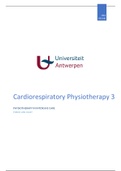Summary
Samenvatting 1MA cardiorespiratory physiotherapy 2 - Physiotherapy in the ICU
- Course
- Institution
Samenvatting 1MA revalidatiewetenschappen en kinesitherapie, cardiorespiratoire physiotherapy 2. Onderdeel: Physiotherapy in the ICU
[Show more]




